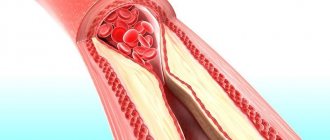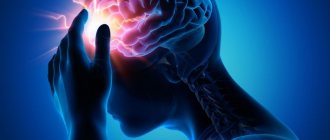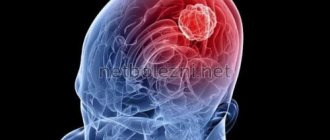Atherosclerosis is a chronic disease of the arteries, which occurs due to disturbances in fat and protein metabolism and is accompanied by the deposition of cholesterol and lipoproteins on the inner walls of blood vessels. These deposits form in the form of plaques. Due to the subsequent proliferation of connective tissue (sclerosis) and calcification of the vessel walls, deformation and narrowing of the lumen occurs, leading to blockage of the vessel. The main danger of atherosclerosis is a significant increase in the risk of developing coronary heart disease. Due to the fact that the disease is becoming the main cause of this and other serious health problems, the prevention and treatment of atherosclerosis must be given due attention.
Treatment of atherosclerosis is complex and includes a number of measures related to lifestyle correction, dietary changes, giving up bad habits, as well as drug treatment that helps restore normal metabolism in the body.
Symptoms of cerebral atherosclerosis
If a patient has cerebral vessels affected by atherosclerosis, symptoms and treatment can be quite varied. However, there are a number of manifestations of this disease that are common to most cases.
- The initial stage of the disease is characterized by negative changes in the psyche. The patient becomes irritable, often experiences neuroses, depressive moods, gets tired quickly, and feels inhibited. Unreasonable headaches occur, the head sometimes becomes heavy, and sometimes a pressing feeling appears. And the main symptom is memory impairment: first, the patient has difficulty remembering new information, and then cannot remember past events.
- Then atherosclerosis of the cerebral vessels manifests itself in the form of more serious mental disorders. Patients are constantly concerned about their own state of health and suspect various pathologies. Delusions of persecution often occur, and sensitivity to external factors (stress) increases. New physiological symptoms appear: tingling, burning in different parts of the body.
- In an advanced state, the patient practically loses the ability to care for himself, and dementia develops. The patient does not remember new information, although he can still remember past events. He is disoriented in time and space, and therefore requires constant supervision. Transient ischemic attacks occur with disorders of speech, vision, and sensitivity. Circulatory disorders in the brain lead to spasms and strokes.
Vascular atherosclerosis: fight and signs
Once identified, remedies are prescribed that will cleanse the lines that supply oxygen to the brain and the body as a whole. The procedures are prescribed for a lifelong period; it is necessary to take medications that correct blood pressure as necessary, reduce the degree of blood viscosity, and increase the intensity of oxygen supply to the organs.
It is worth noting that even the most modern methods are most effective only in the early stages. Therefore, it is important to react in advance, since with further progression it is not guaranteed that it will be possible to get rid of all symptoms. In most cases, conservative methods of therapeutic treatment are used, which reduce the risk of death and reduce already manifested deviations.
Diagnostics begins with a survey and identification of disturbing, problematic issues. If necessary, a more accurate assessment of the condition is prescribed using laboratory tests and equipment.
Often, specialists from other areas of medicine, in addition to a neurologist, are involved, this allows us to exclude milder problems:
- An ophthalmologist examines when identifying visual defects;
- An otolaryngologist works in cases of hearing problems.
A number of research techniques allow us to assess the situation of an elderly person. In this case, angiography is used, in which the vessels themselves are highlighted in the images by tinting them from the inside (by introducing a liquid of a contrasting color). Scanning, ultrasound, EMR, radioencephalogram helps to collect information.
A number of simpler tests allow us to complete the flow picture:
Checking coordination includes examining the patient, who stands up straight and stretches his arms forward;
Is it possible to touch the tip of the nose with a finger with your eyes closed;
Check for the presence of tremor of the limbs; to do this, it is enough to check the behavior of the fingers at rest;
Observe behavior when the client looks up.
When donating blood, the presence and number of potentially dangerous compounds (triglycerides, cholesterol, lipoproteins) are assessed. This parameter is not considered a guarantee that a person will develop atherosclerosis, but if the norm is exceeded, he will be classified as a risk group.
The medications are taken in courses twice a year (beginning of spring and end of autumn). In addition to medications, your diet will be adjusted, and you will have to periodically visit physical rooms for procedures.
To reduce the absorption of cholesterol along with foods, doctors prescribe a number of medications:
- Cholestyramine;
- Hemphribrozil;
- Vinpocetine;
- Nifedipine;
- Pentoxifylline.
The drugs belong to anti-exchange resins, fibrates, which slow down the progression (by reducing the content of triglycerides). Drugs such as statins affect already formed plaques, gradually reducing them. Nootropics affect the metabolism of a neurological nature, reducing manifestations at this level. Antihypertensive drugs stabilize blood pressure in the arteries.
For severe manifestations such as stroke, daily intake of Ibertan, Valsartan and similar medications helps.
The risk of coronary disease is reduced by using vitamin E, Actovegin and other similar products. They reduce the intensity of changes in blood plasma.
Blood circulation improves thanks to Caviton or Cinnarizine; they will have to be used in long courses.
In case of mental manifestations (for example, depression), appropriate medications are prescribed. These can be psychotropics, antidepressants and even tranquilizers.
In advanced situations, a person may require surgical intervention; this occurs if the blockage is up to 70% of the lumen. A thorough examination is carried out in advance.
Several types of operations are common:
- Based on advanced technologies such as laser;
- Stenting. An expander with a special composition is built into the network, which destroys cholesterol deposits;
- Shunting. The surgeon forms and integrates a new vessel into the network, the clogged one is removed;
- Atherectomy. The plaques are literally cut out with a small amount of tissue.
In each clinical case, the selection of the optimal solution to problems is carried out individually. Only an experienced doctor can select medications and healing methods, therefore we invite you to our network of clinics.
Causes and risk factors
Pathology occurs due to metabolic disorders and cholesterol circulation. It accumulates in the body and is deposited on the walls of blood vessels in the form of plaques consisting of fibrin and other substances.
Main risk factors:
- excessive drinking and smoking;
- hyperlipidemia (high cholesterol);
- arterial hypertension and other vascular diseases;
- obesity and diabetes;
- constant stress;
- sedentary lifestyle;
- hormonal imbalances.
A person may also be genetically predisposed to this disease (close relatives have had strokes or heart attacks). In addition, there is an age-related risk factor: men over 45 and women over 55 are susceptible to atherosclerosis to the maximum extent.
Diet
Changing your diet is also a way to improve your well-being and is a great help for other treatment methods. Atherosclerosis very often progresses precisely against the background of poor nutrition and lifestyle, so it is necessary
- follow a certain diet:
- reduce consumption of red and fatty meats and meat in general;
- limit the consumption of confectionery products and baked goods;
- eat as few egg yolks as possible;
- limit solid vegetable fats – margarine – in the diet;
- completely eliminate alcohol, sausages, fast food, and canned food.
Recommended products include vegetables (fresh, pickled, dried), cereals (rice, buckwheat, barley, millet, oats, flax, etc.), dried, fresh and dried fruits, turkey and chicken fillets, river and sea fish.
You need to eat at least 5 times a day at the same time in small portions. It is necessary to avoid fried foods and prepare food using the methods of boiling, steaming, stewing, and baking.
Diagnostics
Treatment of cerebral vessels should be preceded by a high-quality diagnosis, during which the doctor will determine the localization of plaques, the degree of their development, and assess the condition of the organs.
When undergoing diagnostics, it is important to follow a comprehensive principle, since the disease has many manifestations and complications. Therefore, do not be surprised if you are also asked to visit an ophthalmologist, cardiologist, neurologist, or vascular surgeon. Try to tell the doctors in as much detail as possible about the anomalies you notice in the body’s functioning.
The most effective and modern methods are:
- various types of electrocardiography with stress tests;
- Ultrasound of cerebral vessels;
- duplex and triplex scanning with ultrasound examination of blood vessels;
- magnetic resonance imaging (allows you to visually assess the condition of blood vessels and examine atherosclerotic plaques);
- angiography, coronary angiography - minimally invasive examinations, during which the doctor evaluates general atherosclerotic lesions.
The patient also undergoes a series of laboratory tests, the purpose of which is to identify metabolic disorders, hormonal imbalances and other causes of the development of pathology.
Examination methods
To establish a diagnosis and clarify the degree of progression of atherosclerosis, the following are usually prescribed:
- clinical blood test (to assess the patient’s general health);
- ultrasound examination (vascular Dopplerography): to assess the condition of the vascular system, identify plaques, blockages, clarify their location, etc.;
- MRI of the brain: to assess processes occurring in the brain and obtain detailed information;
- urine and blood tests to determine cholesterol;
- blood test to determine lipid balance;
- X-ray with contrast: to identify lesions and assess the functioning of the lymphatic and vascular systems.
Treatment of cerebral atherosclerosis
If the patient has an early stage of cerebral vasoconstriction, treatment consists of drug therapy and lifestyle changes (diet, giving up alcohol, smoking, increasing physical activity). The goal is to reduce cholesterol levels to normal.
Drug therapy in the treatment of cerebral vascular spasms is aimed at strengthening the walls of blood vessels and stabilizing the atherosclerotic plaque. As a result, the development of atherosclerosis is inhibited, and lipid metabolism in the body is normalized. To prevent complications, statins, fibrates, and antiplatelet agents are used.
Among the surgical treatment methods, stenting and bypass surgery are common. In particular, stroke is prevented by stenting the carotid arteries.
- Operations to remove the plaque are carried out in an open manner (endarterectomy): access to the damaged vessel is organized, it is dissected, the plaque is removed, then a vascular suture is applied, and the tissue is sutured.
- The closed method involves the use of an endoscope and a stent. The operation is performed through a small (1-3 cm) incision, through which access to a large vessel is provided. A special catheter is brought through the circulatory system to the site of narrowing of the vessel, and then an artificial stent is inserted through the catheter, expanding the lumen of the vessel and strengthening its walls.
Prevention
Below are a few useful habits that will help significantly reduce the risk of developing atherosclerosis:
- to give up smoking;
- nutrition balanced in composition of nutrients;
- correction and maintenance of optimal body weight;
- annual preventive monitoring of lipid and blood sugar levels.
The diagnostic capabilities of our center allow us to establish a diagnosis quickly and accurately. Based on the results of the examination, you will be advised by experienced neurologists, whose knowledge has helped save hundreds of patients.
Also, individual health monitoring programs have been developed on the basis of the Federal Scientific and Clinical Center of the Federal Medical and Biological Agency of Russia.
- for men (under 40 years old, over 40 years old, standard);
- for women (under 40 years old, over 40 years old, standard based on age and optimal)
Don't put off taking care of your health. Call us or make an appointment to assess your risk of atherosclerosis and receive comprehensive recommendations.
Prevention of cerebral atherosclerosis
- Daily physical exercise will help keep your blood vessels toned: physical activity that is appropriate for your age should be at least 40 minutes a day.
- To normalize cholesterol levels, watch your diet, weight, follow a special diet, and give up bad habits.
- Walk more in the fresh air to saturate your blood with oxygen.
- Limit emotional stress - protect yourself from stress.
- Monitor your blood pressure and glucose levels.
4.Treatment
Neuropsychiatric specialists deal with cerebral atherosclerosis. And if the question of complete healing and restoration of already lost functions is not raised today, then it is possible and necessary to significantly slow down the process by improving the somatic and psycho-emotional state of the patient. A special diet is prescribed; all self-destructive habits, of course, are completely excluded. An individual medication regimen is selected: anti-cholesterol, hypotensive, antiplatelet, vitamin-antioxidant, nootropic (all components according to indications), as well as certain types of massage, exercise therapy, herbal medicine. In some cases, vascular and neurosurgical interventions are indicated and successfully performed.
In conclusion, here is a saying from dark medical humor: the connection between atherosclerosis and old age is that both processes are incurable. But if with regard to old age it is indeed better to refrain from commenting, then regarding atherosclerosis we will still risk clarifying: it is irreversible YET, at the present time of the development of our knowledge, ideas and technologies. Let us remember: what kind of diseases were not considered incurable, including quite recently.
Vascular atherosclerosis: treatment and diagnosis at CBCP
At an early stage of the disease, it is extremely important to undergo a high-quality diagnosis and begin treatment, during which negative consequences can be minimized. If you notice alarming symptoms, contact the Center for Circulatory Pathology, where you will be offered modern diagnostics and effective treatment methods.
CBCP provides a wide range of methods that provide objective and detailed information about the patient’s condition: location of pathology, complexity, possible complications.
Causes of atherosclerosis
The causes of atherosclerosis remain not fully understood. It is believed that the initial stages of atherosclerosis occur already at a young age, but it usually reaches its clinical significance in people of the older age group (over 50 years). There are risk factors for atherosclerosis, the impact of which can significantly slow down its progression, reduce the severity of its manifestations and prevent the occurrence of complications.
Risk factors for atherosclerosis
- High blood pressure,
- High levels of cholesterol in the blood - low-density lipoprotein (LDL),
- Diet high in animal fats
- Smoking,
- Obesity,
- burdened heredity,
- Diabetes.
Cholesterol and atherosclerosis
It is important to regularly monitor blood tests for the so-called “bad” cholesterol, which is deposited in the artery wall and causes the appearance and growth of atherosclerotic plaques. If the level of low-density lipoprotein cholesterol is elevated, you should consult a physician, cardiologist or vascular surgeon. In the absence of contraindications, it is recommended to take statins - medications that reduce the level of “bad” cholesterol in the blood.










